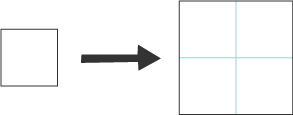Or search by topic
Number and algebra
Geometry and measure
Probability and statistics
Working mathematically
Advanced mathematics
For younger learners
Twice as Big?



If we double each side of a small square we get a new enlarged square:

The new enlarged square is the size of four of the smaller squares.
This also happens when we enlarge other shapes. Some, like the squares, can be filled with the same smaller shape.
Look at these:
Can you work out how the four shapes fit to make the enlarged shape each time?
You need to rotate or reflect the smaller shapes to fit them in. (This means that if you make them from squared paper you will need to turn them round or turn them over.)
Please send us pictures of your completed shapes.
In this interactivity the rotation and the reflection of the shapes has been done for you.
If you enjoyed working on this problem, you might like to investigate some more shapes. Have a look at Two Squared or print out this sheet which contains some other examples as well as the shapes above.
You may also like
Cutting Corners
Can you make the most extraordinary, the most amazing, the most unusual patterns/designs from these triangles which are made in a special way?
Cut and Make
Cut a square of paper into three pieces as shown. Now,can you use the 3 pieces to make a large triangle, a parallelogram and the square again?
Square to L
Find a way to cut a 4 by 4 square into only two pieces, then rejoin the two pieces to make an L shape 6 units high.

